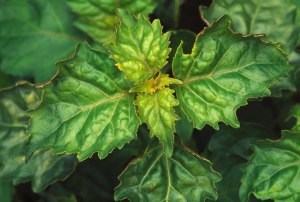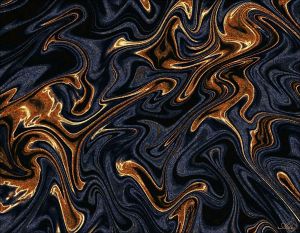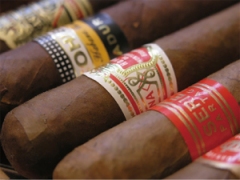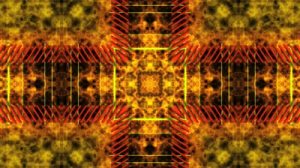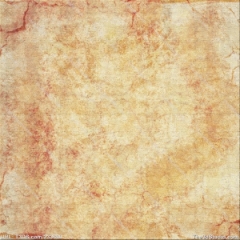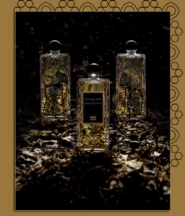Somewhere, there is a horseman who smells like this — and, I don’t mean that in a bad way. Lui is a patchouli fragrance with a surprisingly animalic, leather twist, and I quite enjoyed it. It is the scent of dark, slightly dirty patchouli infused with the aroma of a leather saddle and a heated, musky horse galloping over earthy vetiver. Despite an intensely masculine opening, its animalic nature is ultimately a refined one that calls to mind virile, macho polo players more than cowboys on the range. On the right skin, it would be sexy as hell. On me, it was a bit less than what I had expected.

“Dressage Black and White” by Diana Rose Greenhut or DianaExperiment. http://www.flickr.com/photos/dianagreenhut/5830354123/
Lui is an eau de toilette from the Italian niche house of Mazzolari. The house goes back to 1888, but Lui was released in 2006. As a lover of dark patchouli fragrances, I couldn’t believe my eyes when I read its description and the sheer range of gushing, raving reviews. It seemed like Lui might be my Holy Grail for patchouli, a scent good enough to tempt me into considering a blind buy. I’m glad I tested it first because, intriguing and interesting as it is, I’m not in love with it.
Some basic details on the fragrance are hard to obtain. Mazzolari’s website is best navigated by someone who speaks Italian — and that is not one of my languages. I can’t find any information on who created the scent, and I don’t trust Google Translate’s version of Mazzolari’s description for the scent. So, let’s go with Luckyscent which describes Lui as follows:
Potent and virile, Lui is the fragrance of a refined man with a wild streak a mile wide. Rich with patchouli, vetiver and leather, this is a complex and unguarded scent, completely comfortable on the skin yet smokin’ hot underneath. Hints of sandalwood tame the wild animal, while a dark amber and rich musk enhance the raw sensuality of Lui. Raw and elegant at the same time, Lui is an uninhibited fragrance for a man who likes to keep everyone guessing…and just a little on the edge.
The notes — as compiled from Luckyscent, Fragrantica and elsewhere — seem to be:
Indonesian patchouli, vetiver, leather, sandalwood, Texas cedar, spices, ambergris and flowers trails.
Lui opens on my skin with patchouli dominated by a leather note that feels raw, very butch, and somewhat fecal. It smells a little like the inside of a brand new, extremely expensive leather shoe that has a touch of horse manure smeared on its sole. The leather has a strong whiff of sweaty horse attached to it. In short, it’s raw, animalic, slightly musky, earthy, and a bit fecal, all at once. For me, it was an instant flashback to the smell of my own horse after a long ride and of being in the stables afterwards. I didn’t mind it one bit, and actually enjoyed the very equestrian feel of it. It also strongly called to mind the horsey note in an old, classic, leather fragrance, but I can’t seem to recall which one it might be. (It’s not Hermès’ Equipage.) Regardless, it’s a twist on leather that I find more interesting than that in many modern leather fragrances that I’ve tried recently, though I have to wonder how some non-equestrians might take it. Women, in particular, may find Lui’s opening to be overly masculine, and the leather a little bit too raw.
The horsey leather aroma completely overshadows the patchouli in the opening minutes, and is soon joined in its potent blast by a strong, rooty earthiness from the vetiver. The latter feels sharply green, almost herbal in nature, and with a slight funk that adds to the unexpected twist. Something about the overall combination really feels like the musky, sweet earthiness of a slightly heated horse, its sweaty leather reins, and the whiff of the stables all around. Yet, it’s not hardcore barnyard by any means. I have a friend who is in the racing and horse world, and he often retains the lingering traces of his day on his skin, even after a shower sometimes. If you imagine patchouli’s dark, slightly spicy, slightly smoky sweetness infused with an earthy greenness and a strong trace of the horse world on a very masculine guy’s heated, slightly musky skin, then you’d have the feel of Lui’s opening minutes.
With every passing minute, however, the horsey leather loses its fecal edge and softens its initial intensity, though its animalic essence never fades completely away. Instead, 45 minutes in, it retreats to the sidelines to hide behind the patchouli. At the same time, the sandalwood and some abstract, amorphous spiciness rear their head in the base, adding a woody depth and richness to the fragrance. More noticeable is the growing hint of a slightly smoky, green cedar lurking about the edges. It creates a strong visual of dark greens, rich red-browns, and leathery darkness. The overall effect calls to mind an elegant dressage equestrian or tough polo players, not John Wayne wearing chaps and riding on a Western saddle on a desert range. Somehow, the horsey leather in Lui is a very refined note despite its masculine edge.
Lui is primarily a triptych of patchouli, leather and vetiver, that never changes its core essence for an incredibly long period of time. The degree and strength of the three main notes fluctuate over time, as does the indirect impact of the notes in the base, but Lui is really a leather-patchouli scent with vetiver. At the end of the second hour, Lui feels like soft swirl of patchouli from afar, but every time you sniff your arm closely, the animalic, hard, horsey leather pops up. Hour after hour, I thought it may have finally vanished, but it lurks behind the patchouli’s dark richness. The vetiver eventually melts fully and completely into the scent, joining the subtle, almost indirect, muted sandalwood and spices in the base, but the leather never does. It never loses its distinct touch of the stables either, no matter how light it may be. I like it — but I’m admittedly rather passionate about the horse world.
It takes about nine hours (!!) for Lui to change a little, and, even then, it’s only temporary. The fragrance takes on the slightest tinge of powderiness, and Lui becomes much sweeter, too. The powder is never significant, however, and only lasts an hour or two before Lui returns to its primary bouquet of patchouli with hints of leather. Lui remains that way until its very end, an astonishing 13.25 hours later. Did I mention that this is an eau de toilette?!!
Lui’s potency is something that is frequently mentioned in comments on places like Luckyscent. An an eau de toilette, the fragrance has a certain lightweight feel and thinness. Yet, it also has the strength of a powerful eau de parfum. For the first two hours, Lui felt like a very noticeable but soft, airy cloud that hovered about 2-3 inches above the skin, but then, it quickly dropped and turned even thinner in feel. Its potency, however, was always very good. I had read that two sprays can last forever, but that Lui is better appreciated with a light application. I ignored that last part, and I applied 3 very large-ish smears (yes, I love my black patchouli!) which is probably less than 2 sprays from an atomizer, and I was incredibly impressed by Lui’s longevity. The projection was merely moderate, however, though Lui is strong when sniffed up close for at least 7 hours. At that point, the fragrance finally became a gauzy veil right atop the skin. Even so, it still didn’t take much effort to detect the patchouli leather. If this is an eau de toilette, I can’t begin to imagine what an eau de parfum from Mazzolari might be like!
Lui generally gets extremely positive reviews. Take a look at some of the Luckyscent comments that made me temporarily consider a blind buy:
- Mazzolari Lui is truly mind-blowing. Two spritzes MAX to the mid-section is all you need to enjoy this heady, deep, hypnotizing italian brew. Pure masculine power and erotisism in a bottle.
- Lui is one scent that has elicited more positive comments than any other in my wardrobe. As has been stated, it lasts for hours, and the drydown is just so very nice. I can’t think of any other scent that compares. Wonderfully masculine, yet comforting and should be be in every man’s repetoire of fragrances.
- Way too many new fragrances are samey, dull and unremarkable. Glad I found this. Deep, powerful but refined. Great evening scent. Get a sample, you’ll realise it’s worth the price-tag. I’ve always loved patchouli but it goes sweet on me. This time it didn’t.
- When lightly applied this really shines as a dark, smoldering Patchouli based scent. The Patchouli takes twists and turns and finally gives way to a wonderful Ambergris base. Wonderful, wonderful, wonderful – though apply it lightly or you won’t like it.
Fragrantica commentators are equally enthusiastic. To give you just one example, the assessment by “alfarom” who writes:
- Someone may describe Lui as simplistic, I prefer to say it goes straight to the point with no frills. A dark, butch and testosterone driven animalic bomb, built around a patchouli-amber structure. The opening is brutal with a massive dose of civet and other animalic “amenities”. Definitely not for the faint of heart. A thick patchouli note, breaks in right away and together with amber, drive the fragrance towards a slightly powdery, leathery, endless drydown. Old school, challenging, dirty and by all means mascuilne. [¶] If you like hair-chested types of fragrances such as Parfum D’Habit, Macassar and the likes, this stuff is for you. Me? I’m sold.
Yet, for all that Lui is marketed and loved as a men’s fragrance, women like it, too. One example is the Non-Blonde who tried Lui, and bought a full bottle. Her review reads, in part:
Lui is supposedly a masculine fragrance. The notes are sandalwood, cedar, patchouli, ambergris, vetiver and spices. It’s strong and heavy on the patchouli. Not for the faint of heart, that’s for sure. The impression from the very first note to the drydown is of a dark and earthy scent. The woods aren’t dry. The sweetness is kept in check by the spices (cinnamon? clove? It depends. Nothing too obvious).
The earthiness has reminded my husband of JAR’s very dank and oakmossy Shadow. I’m not sure if the two are comparable, but I sort of know what he’s talking about. The darkness of the wood and the spicy depth of Lui do have something in common with Shadow, but it’s sweeter which makes it more wearable for women. Or, at least, for me. I loved it on my husband as well as on myself. It has a lot of presence and gives an aura of confidence. The patchouli here is sexy, not a head shop scent. It’s strong and would probably not appeal to those who only go for subtle.
The one exception to all these largely similar accounts seems to be Nathan Branch who had a totally different experience, one centered almost predominantly around powder:
Lui by Mazzolari is yet another powdery sandalwood/patchouli kitten masquerading as a musky wild cat. The non-blonde insists that Lui is earthy with dark woods and a spicy depth, and a reviewer at Base Notes waxes on about how animalic and potent it is, but Lui could only be considered “earthy” or “animalic” if you’re used to wearing perfumes that are predominantly violets or lily of the valley.
Lui opens up with a blast of Johnson & Johnson baby powder, then settles itself into heavily sweetened sandalwood and patchouli territory until it rides off into a light musk sunset crowned with plush, pink clouds. There’s nothing particularly singular or interesting in the way it goes about its business, but it’s nice enough for social gatherings and will probably get you some notice, provided you’re hanging out with a group of ex-hippie mothers at a baby shower.
Oh dear. I have to emphasize that his experience seems to be atypical, but I think it’s an important one to keep in mind if your skin amplifies powder notes.
For me, personally, I think I shall pass on Lui. I really liked certain bits of it, and enjoyed my test quite a bit, but I wasn’t wowed or deeply enamoured. The main reason is that I’m looking for a dark, deep, super spicy, opaque, black patchouli fragrance, and Lui sometimes seemed be heavily leather and vetiver in focus. The amber never showed up on me, and the spicy, smoke that I like with my patchouli was almost imperceptible. In short, I was looking for something extremely specific when I tried it, and, in that sense, I was disappointed. In all other ways, however, I enjoyed Lui and think it’s a very good fragrance. I also think it might completely turn my head to smell it on a guy’s musky, warm skin.
Nonetheless, I don’t think Lui is for everyone. You have to love animalic leather that feels almost raw and butch at the start, before it mellows into something smoother, mellower, and softer. You also have to love patchouli with a dirty edge. Those of you used to purple, fruited patchouli of the sort in Coco Noir or any host of commercial, mainstream fragrances, be aware that this is a totally different animal. (Thank God!) Lui is a masculine fragrance in bent, but I certainly think some women could wear it. Women who have a riding or equestrian background, in particular, might absolutely love it. It takes a very familiar aroma, and transforms it in a very refined, sexy manner. In short, if you love patchouli and animalic, masculine leather, Lui is one to keep in mind.







